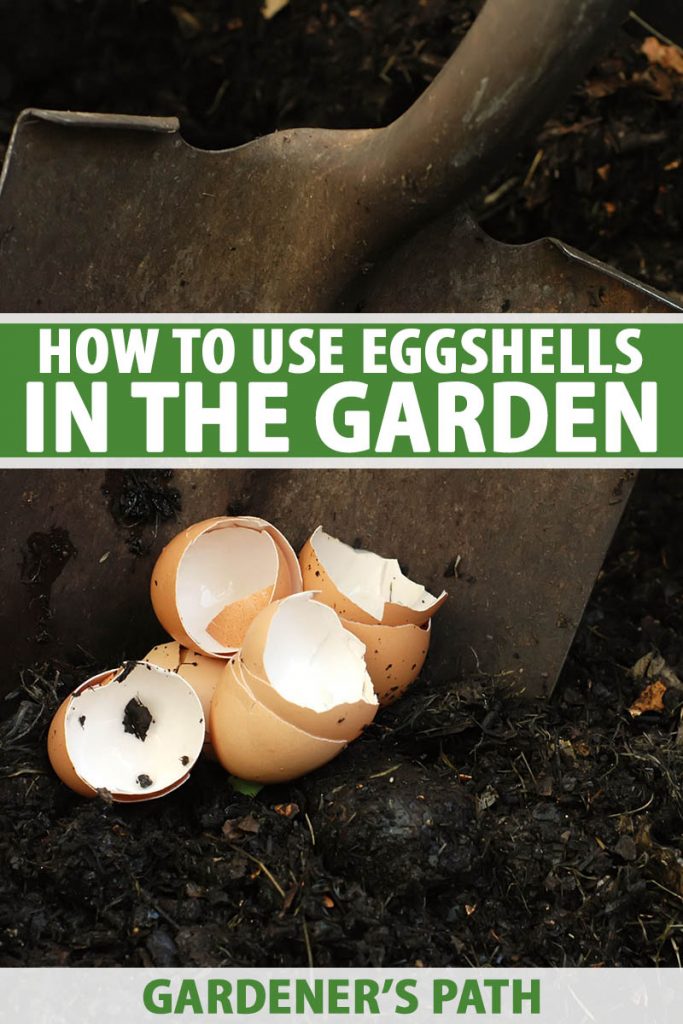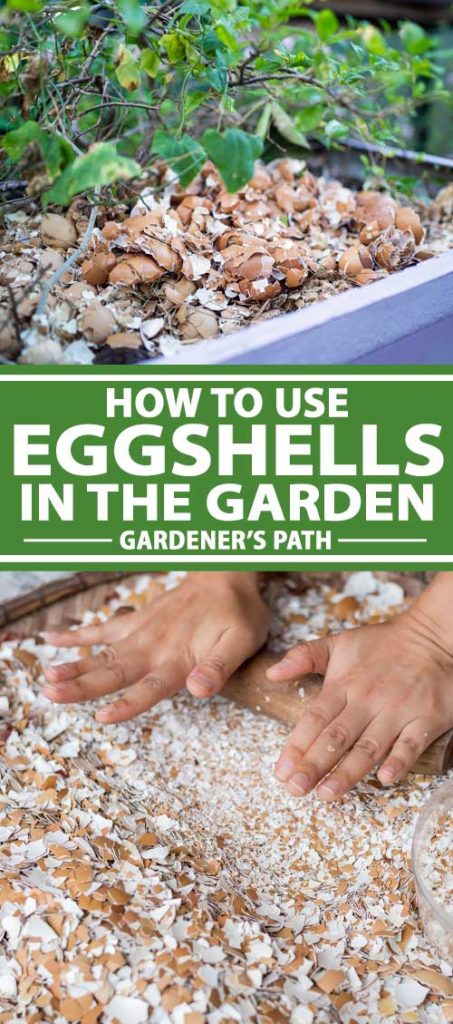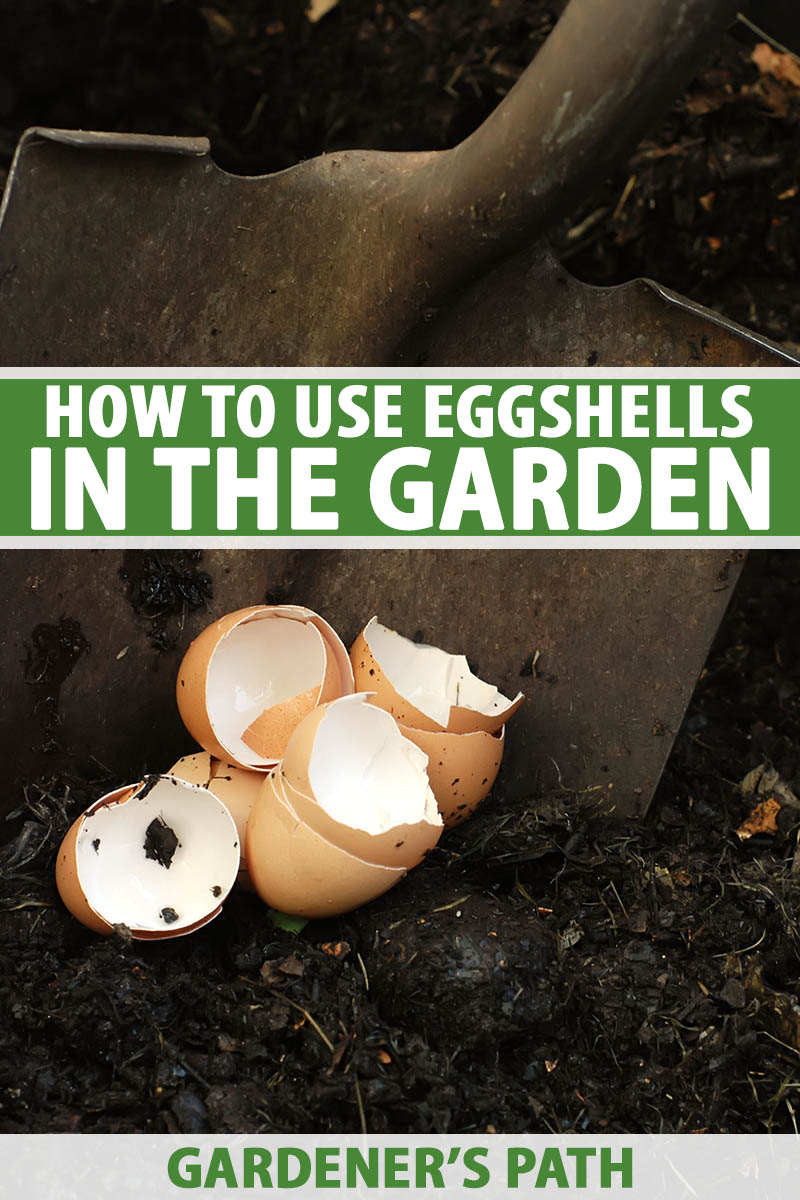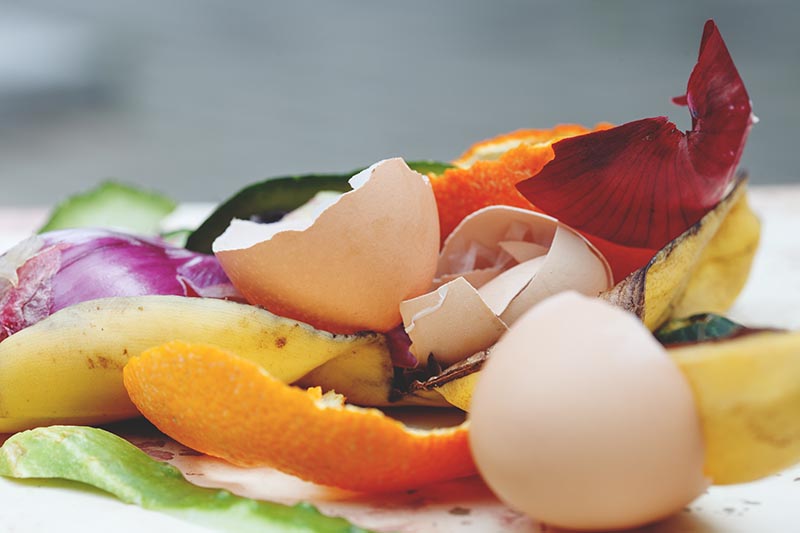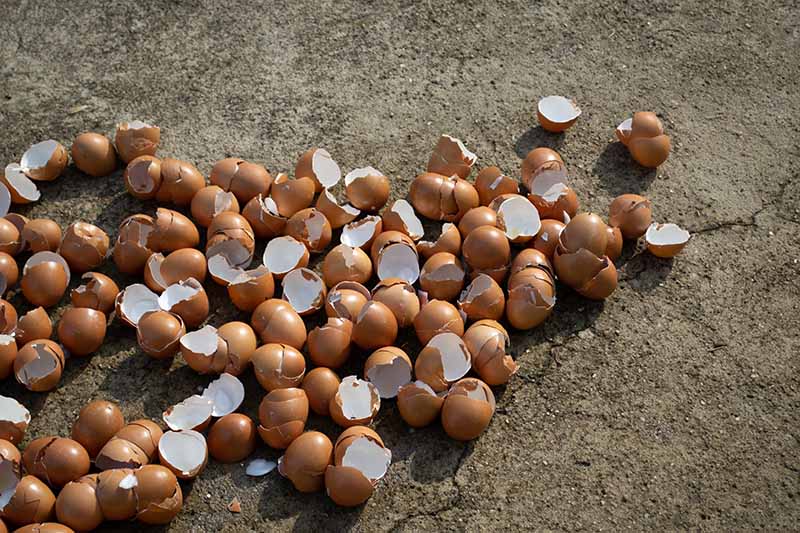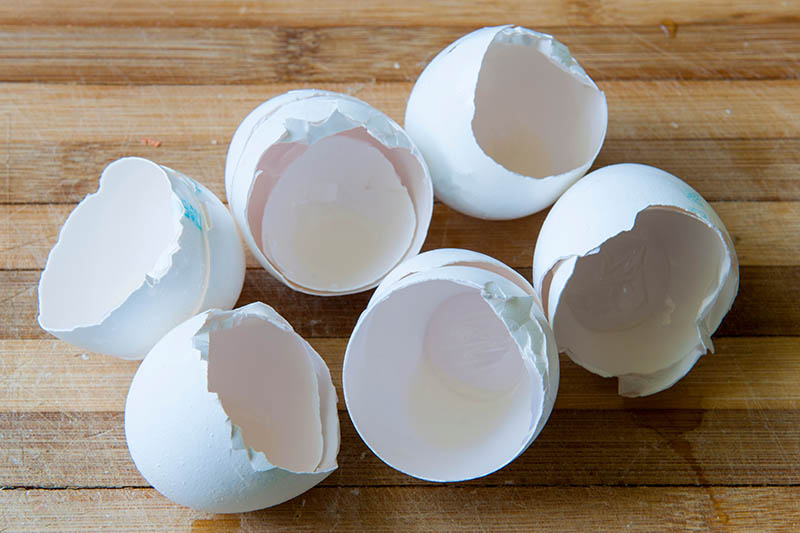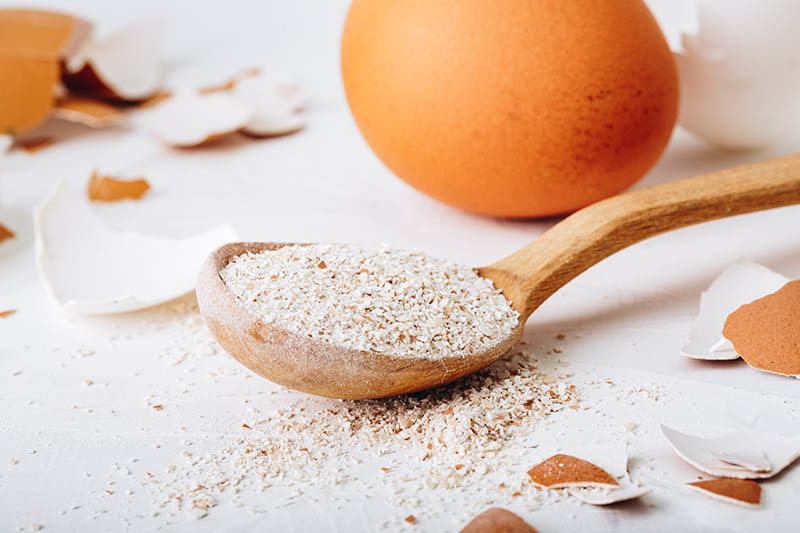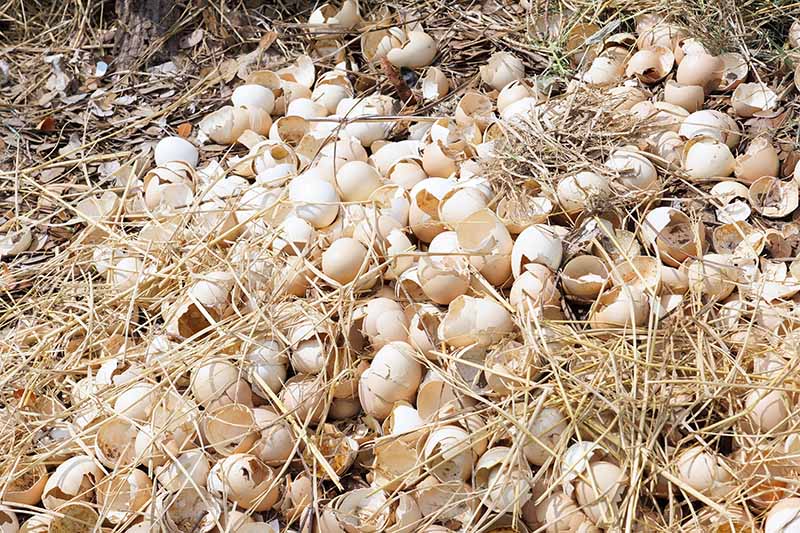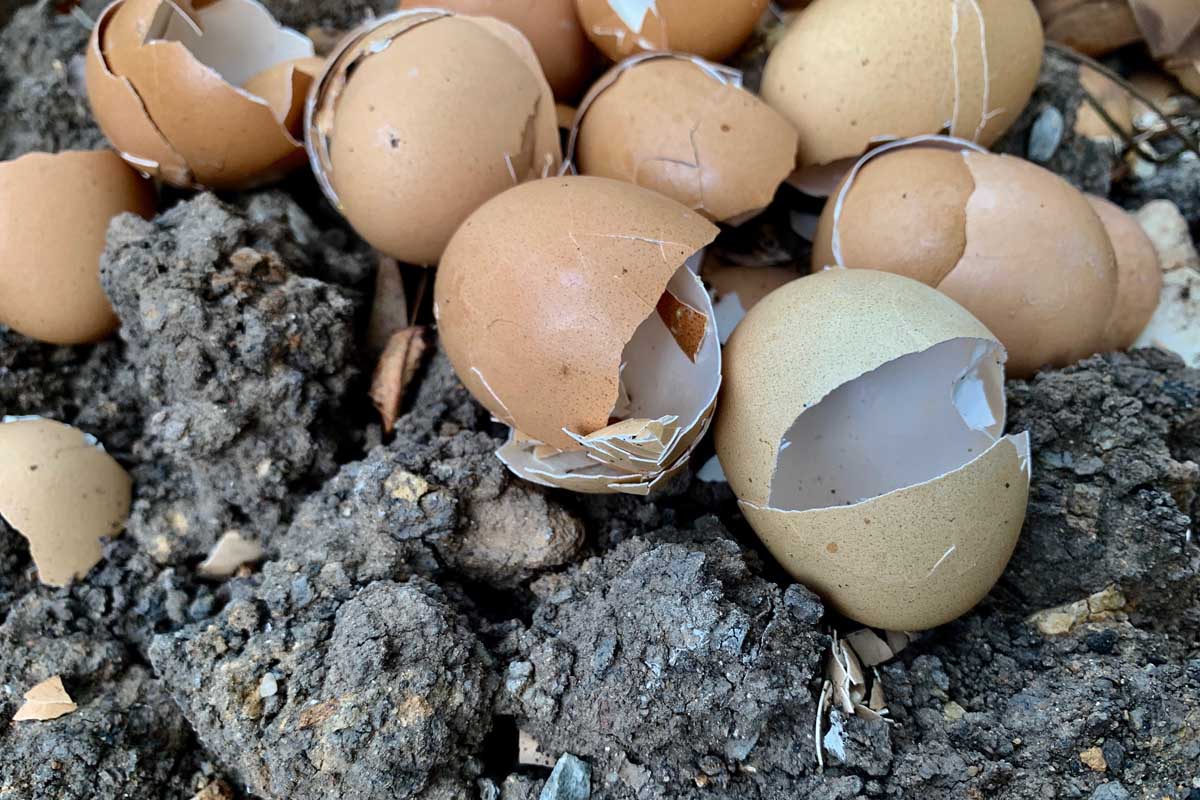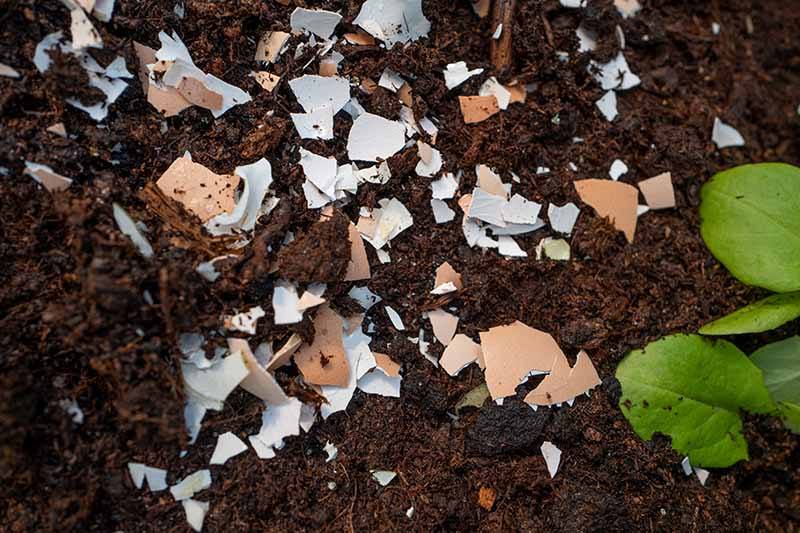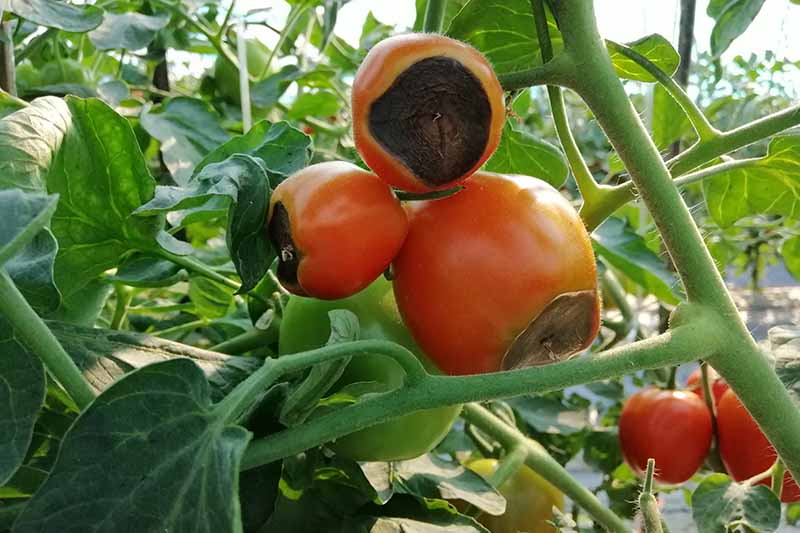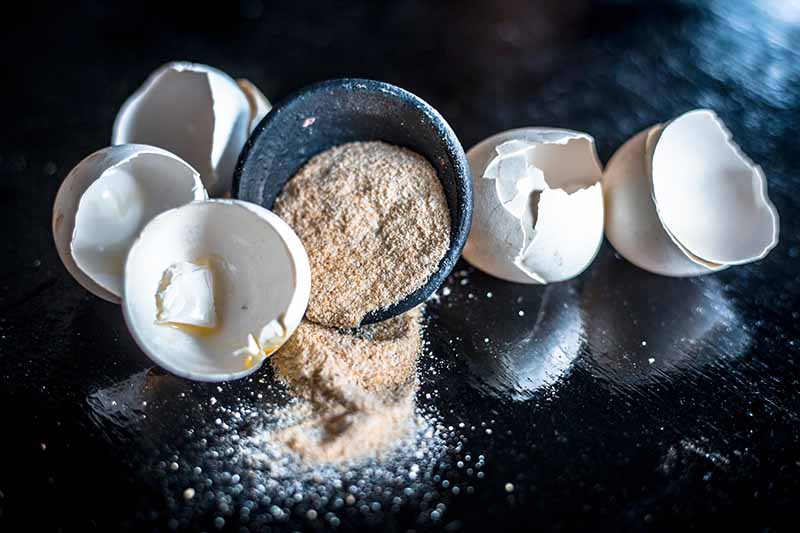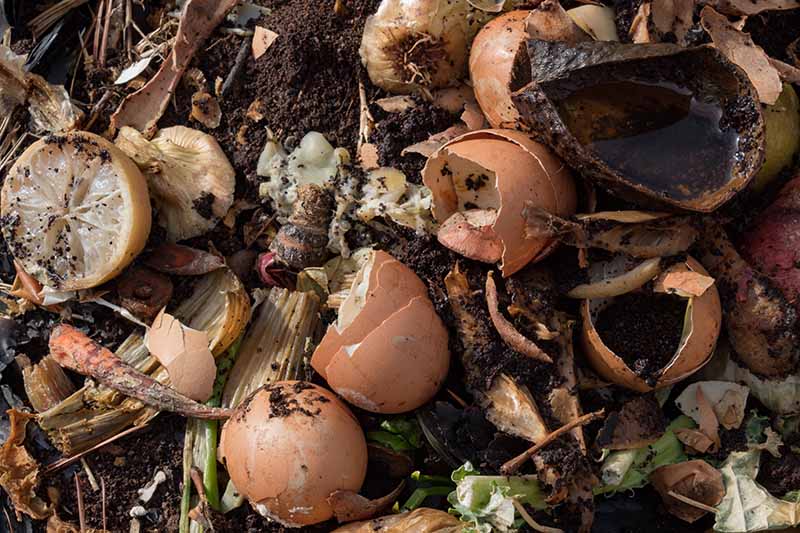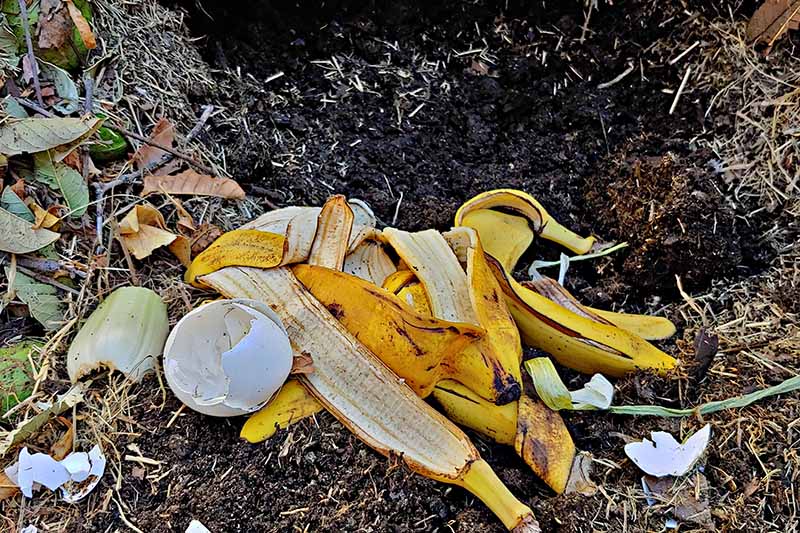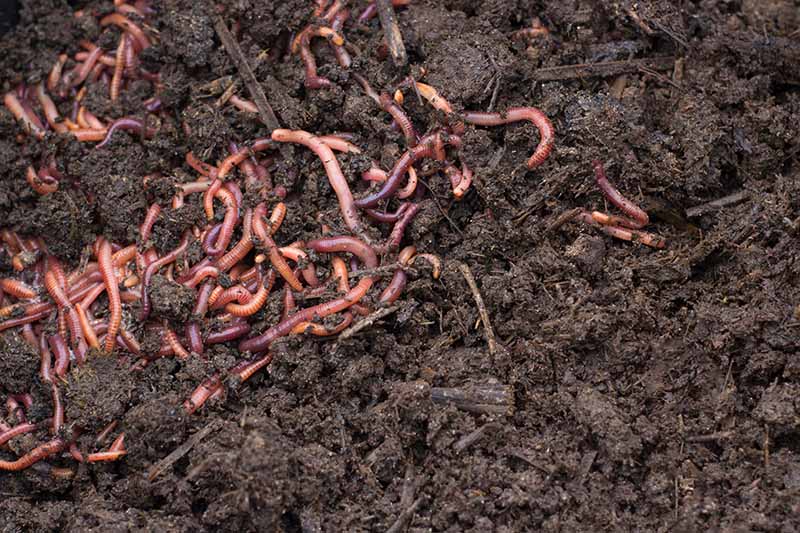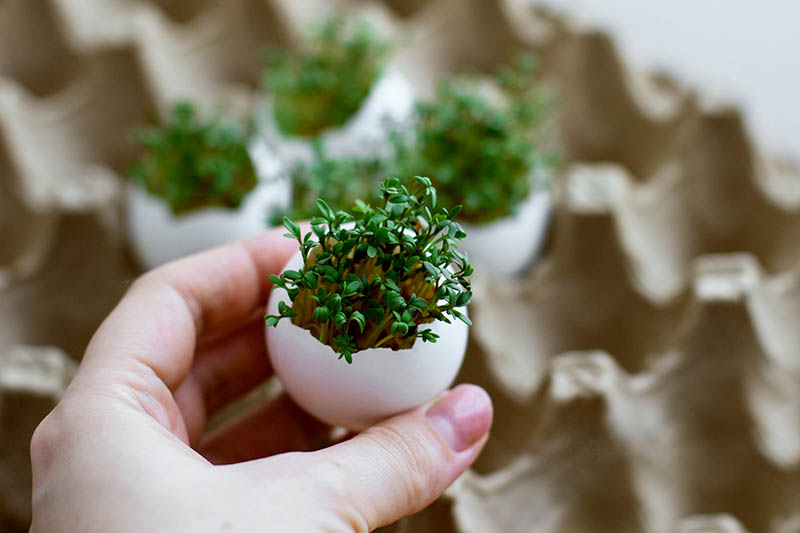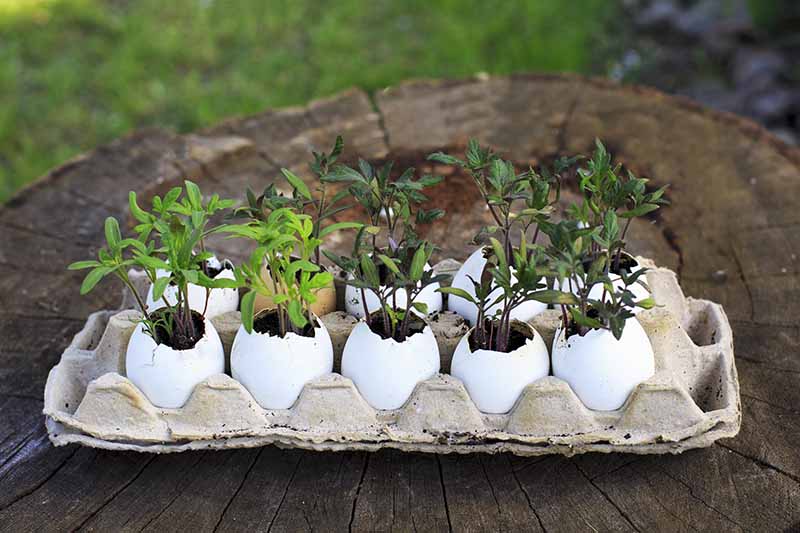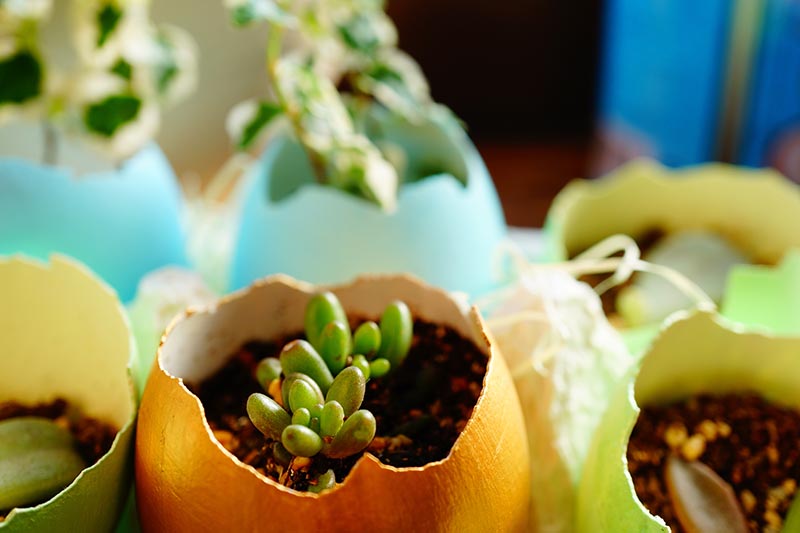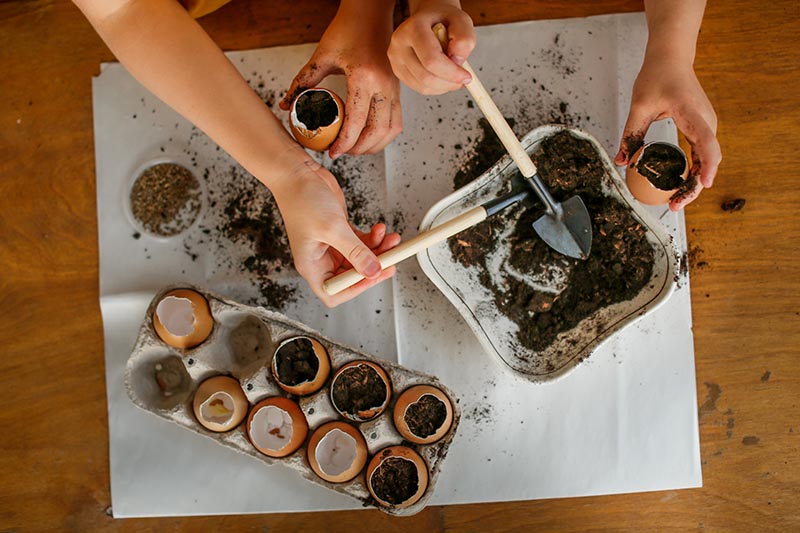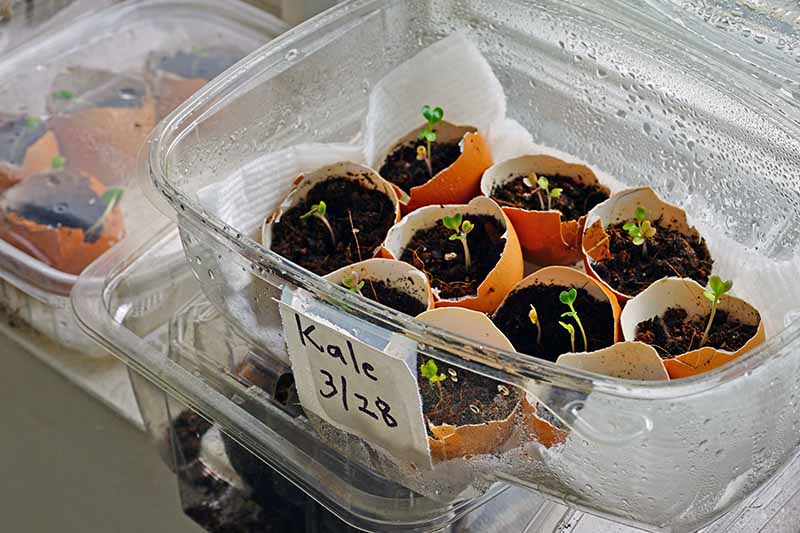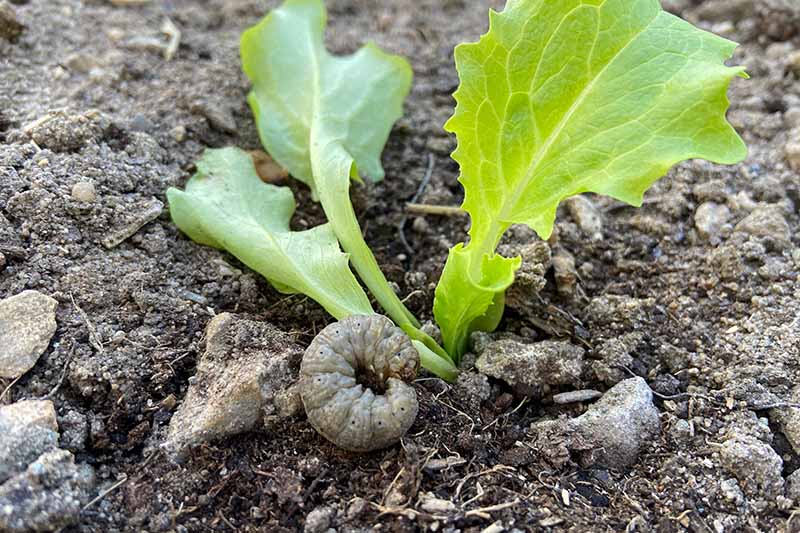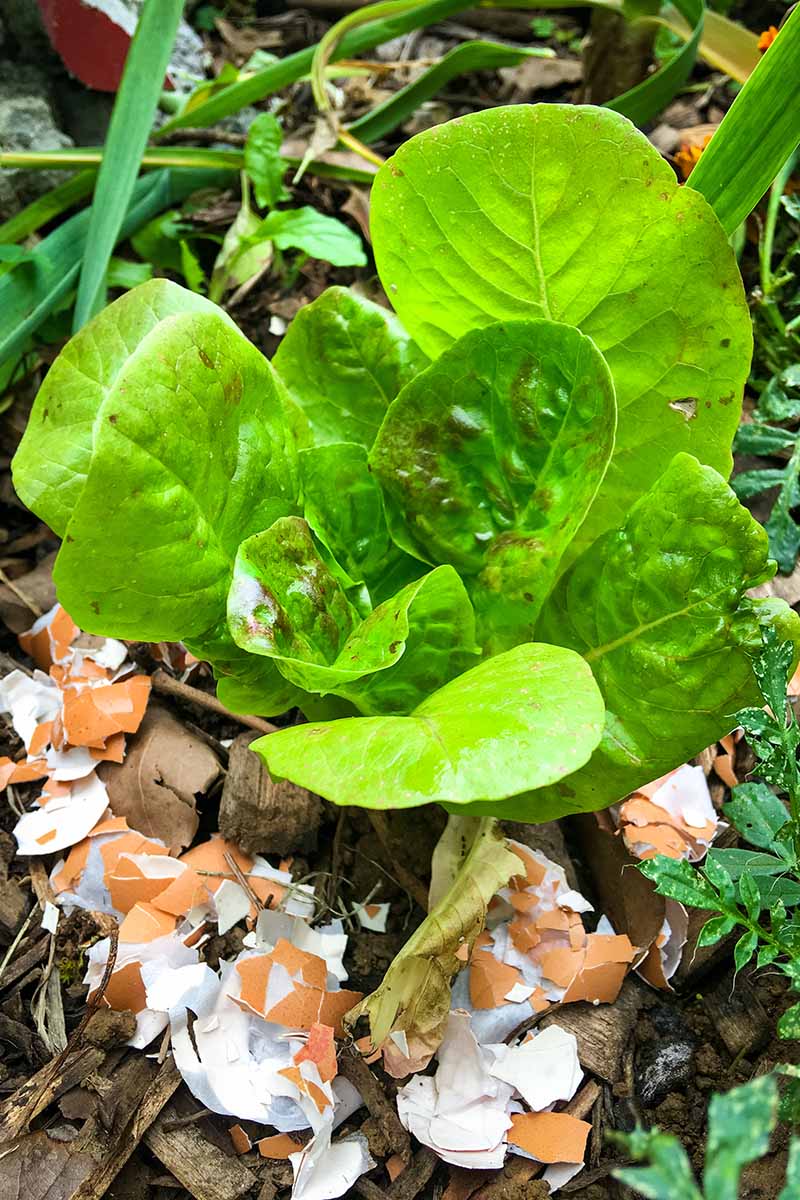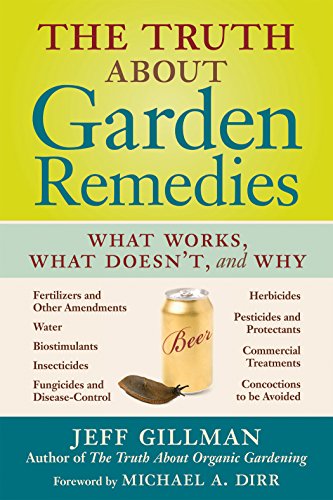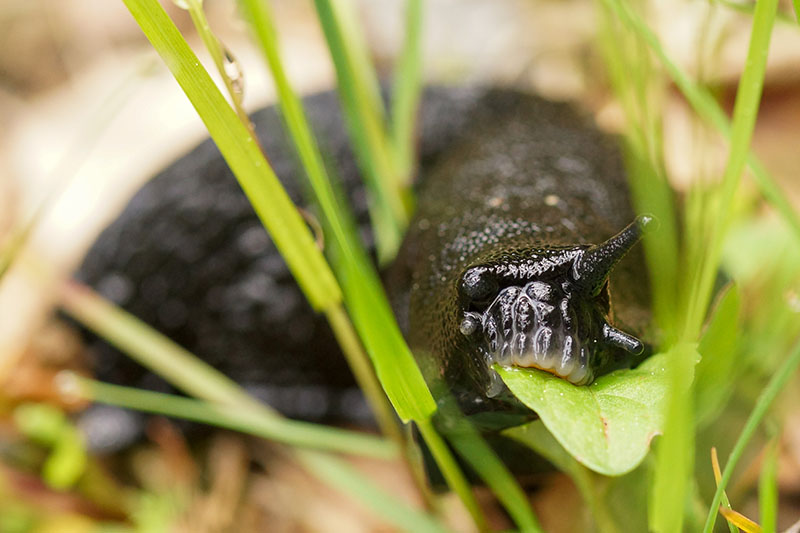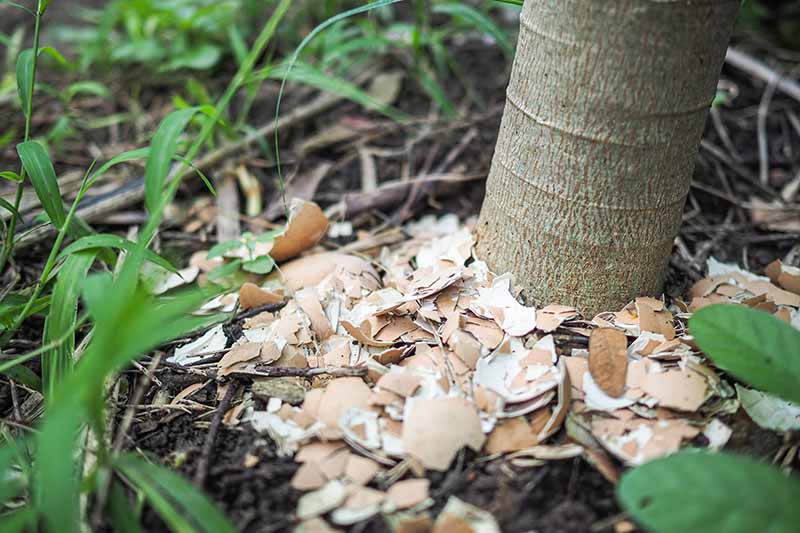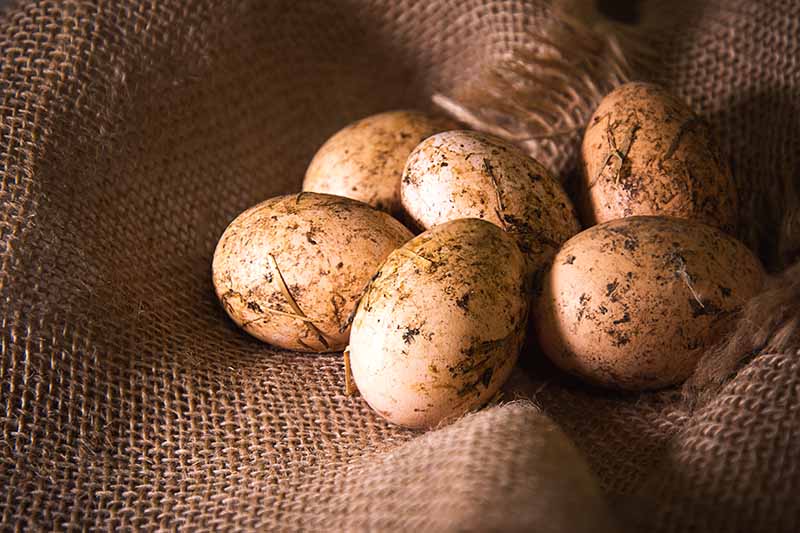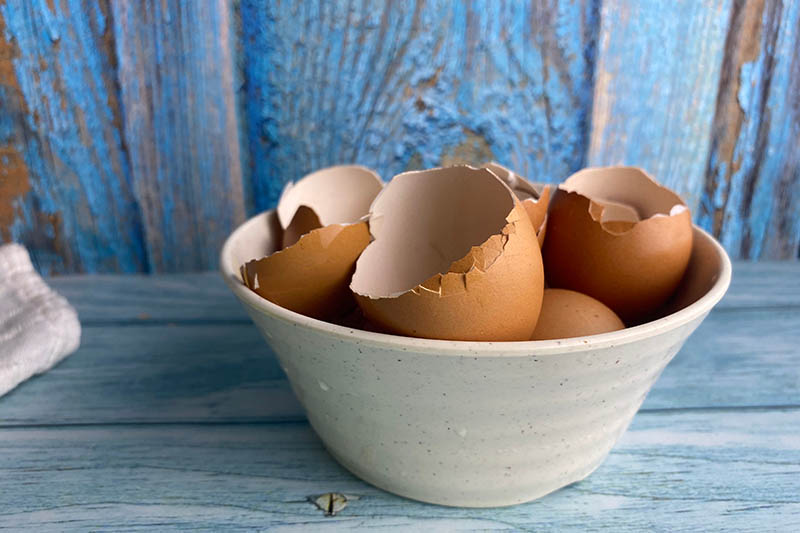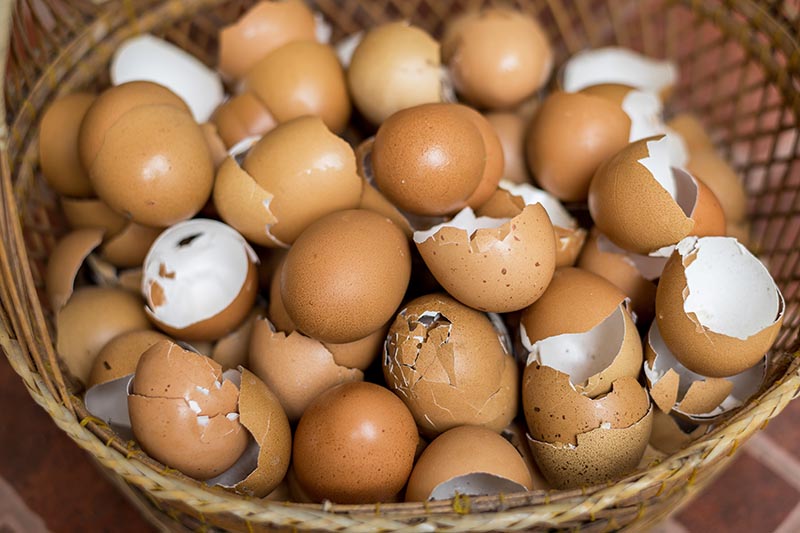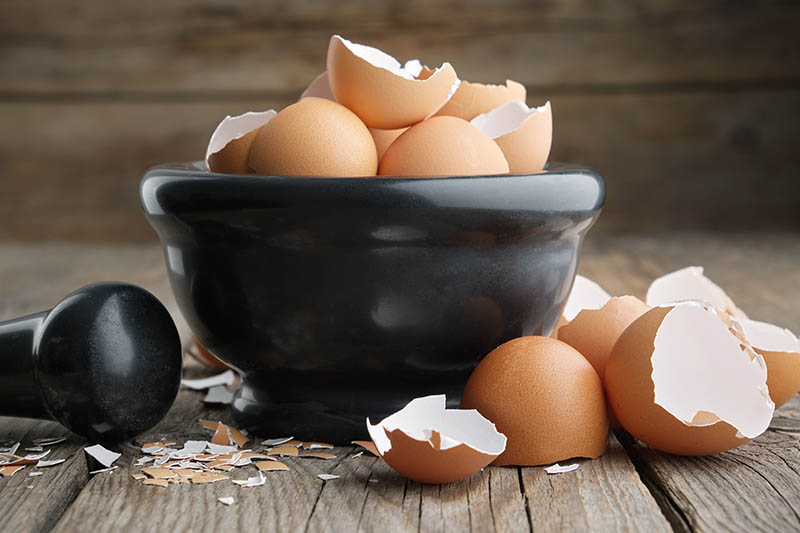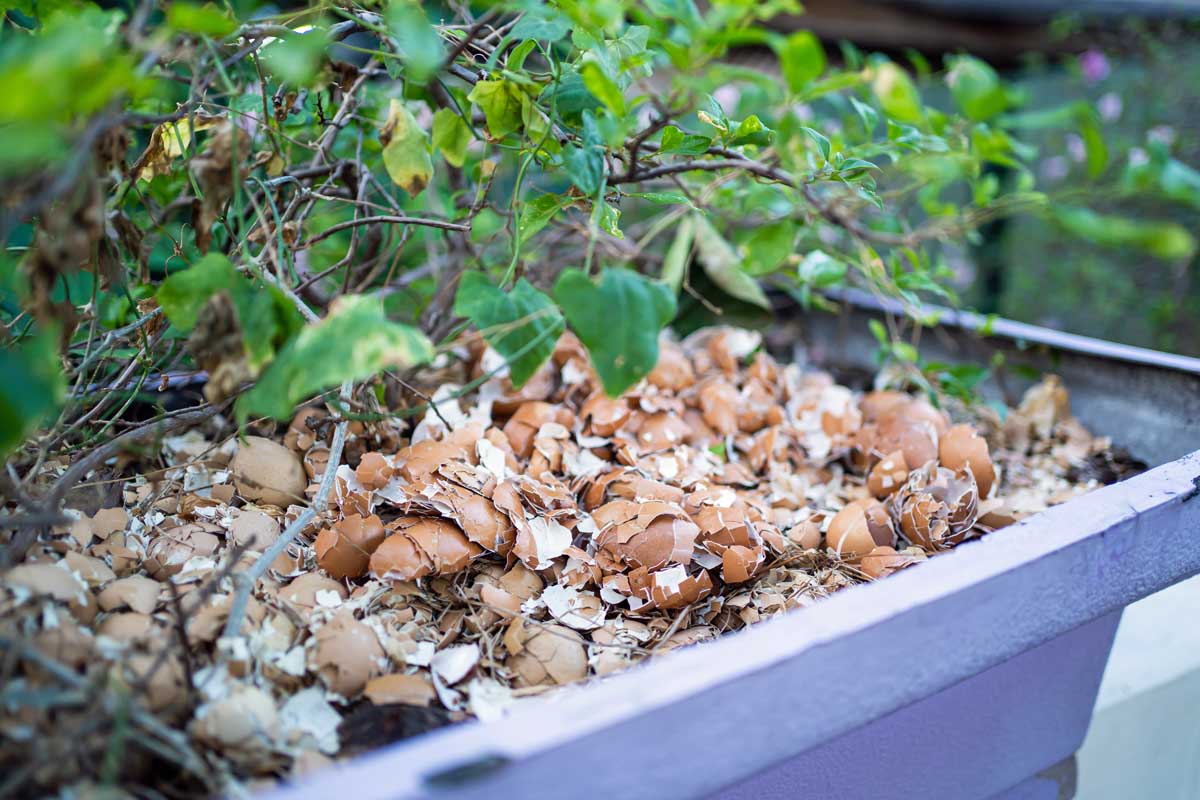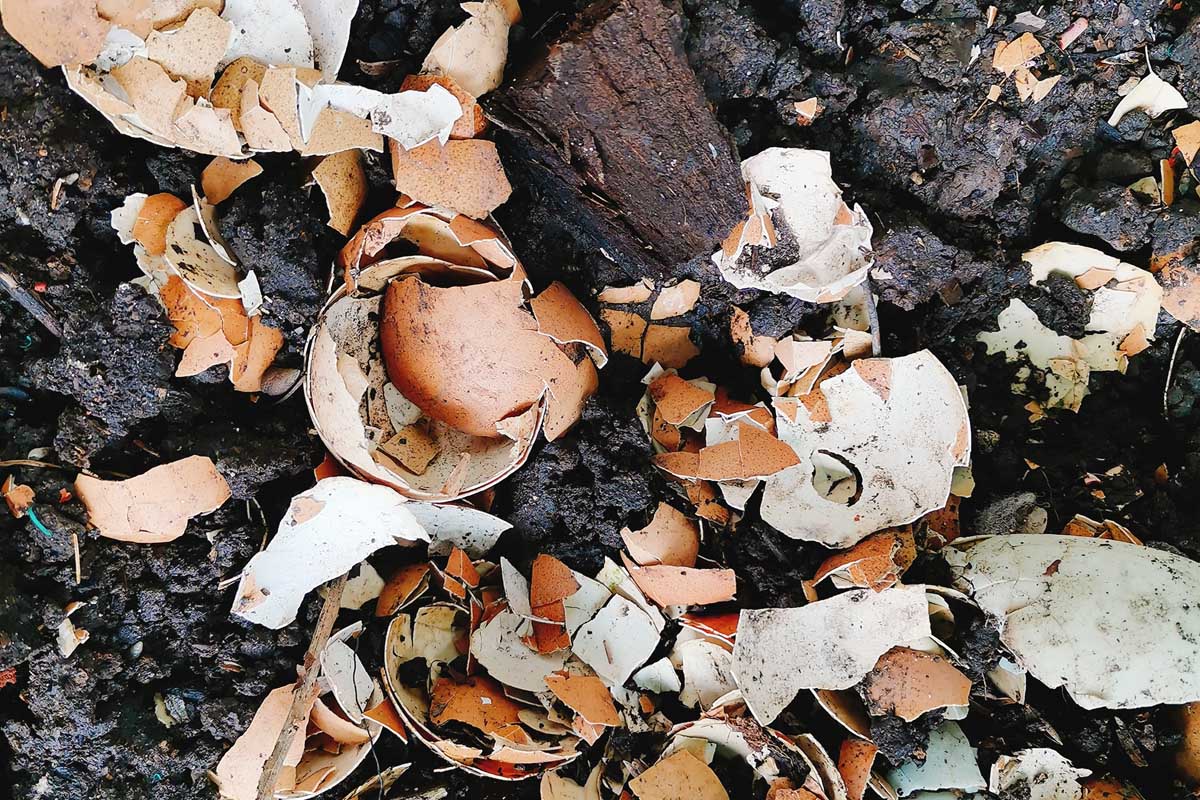I remember my reaction when I dug in to harvest my very first batch of finished compost. I was thrilled that all of my food waste and garden trimmings had magically transformed into a beautiful, brown, humus-like substance! All except the eggshells. Lots and lots of them, all still very recognizable. We link to vendors to help you find relevant products. If you buy from one of our links, we may earn a commission. In addition to discussing the best way to add them to your compost, I’m also going to cover other ways of using them as a soil amendment, and whether or not they work as a pest deterrent. Here’s a quick overview of what’s ahead:
Eggshells as Food Waste
Eggshells take up a whole lot of room when you don’t break them up – whether that’s in your compost or your trash can. Their beautiful oval shapes – so perfect for containing their contents – don’t flatten down well in the trash, unless you take the time to crush them. And many people put them in the garbage without a second thought. According to Paula Felps at Earth911, the US alone sends 150,000 tons of eggshells to landfills every year. If you do the math, that’s nearly a million pounds of these oval wonders taking up space in landfills, not per year, but per day. Yikes! It makes a lot of sense to try to find alternate uses for these empty former packages of eggy goodness. And that’s where home gardeners can get involved.
Eggshell Nutrients
Before we get into the details of how to reuse this abundant variety of food waste in the garden, I think it would be helpful to examine just what exactly is being thrown away at a rate of nearly a million pounds a day. Here’s what the average eggshell is comprised of:
95% calcium carbonate0.3% phosphorus0.3% magnesiumTraces of sodium, potassium, zinc, manganese, iron, and copper
It seems like such a shame to just throw all those nutrients away, doesn’t it? Especially if they could replace a garden product that you might have to purchase otherwise – like agricultural lime. In fact, a study presented at the 2006 Iowa State University Integrated Crop Management Conference by extension field specialists John Holmes and Paul Kassel found eggshells to be an effective means of reducing soil acidity, on par with agricultural lime, which is mined from limestone. And in case you’re wondering, repurposing this type of food waste isn’t just a DIY amendment utilized by home gardeners. Ground eggshell meal is listed as an organic fertilizer “generally acceptable under the [rules of the USDA National Organic Program (NOP)] for commercial organic farmers,” as described in the North Carolina Extension Gardener Handbook published by North Carolina State University, with an average analysis of 1.2-0.4-0.1 (NPK). Though nitrogen, phosphorus, and potassium levels offered by eggshells are relatively low, the takeaway here is that what is usually discarded as waste can be an incredible source of calcium, with value as an amendment used both to feed plants and to neutralize acidic soil.
Use as a Soil Amendment
How can you tell whether your garden will benefit from added calcium? It’s important to understand what type of soil you’re starting with – so make sure you read our enlightening article on this subject. You may even want to do a soil test to see how much calcium your soil already contains. If your soil is acidic, amending with a source of calcium may be helpful, depending on what you want to grow. But there are cases when acidic soil is preferable, such as for growing blueberries and other ericaceous plants. You wouldn’t necessarily want to add an alkaline amendment like calcium in that case. The results of your soil test will help guide you in deciding if adding calcium to your soil is a good idea or not. If you’re growing tomatoes and other food crops that may suffer from blossom-end rot, the calcium from eggshells may be a big help at planting time. In a paper published in the March 2016 issue of the International Journal of Innovative Research in Science, Engineering and Technology, Madhavi Gaonkar and A. P. Chakraborty from Dr. Babasaheb Amebedkar University in Maharashtra, India, described their research on using eggshells as a calcium supplement and fertilizer. These researchers concluded that powdered eggshell is “probably the best natural source of calcium,” and found the use of this amendment could balance soil calcium levels in order to help prevent blossom-end rot. Charles C. Mitchell, extension agronomist with the Alabama Cooperative Extension also studied adding this food waste to the soil in a farm setting to neutralize soil acidity. He determined that adding crushed eggshells to the soil was useless – unless they were ground to a fine powder, smaller than sand. When ground in this way, he found that this powder was even more effective than agricultural lime, providing a source of calcium that was readily available to plants. In short, large pieces of shell break down too slowly to serve as an amendment or soil sweetener. when ground into a powder, they bind to the soil, becoming more readily bioavailable and altering the soil pH. In addition to preventing blossom-end rot in tomatoes, the calcium in ground shells can be used to prevent apple cork spot, or as an alternative to amending your lawn with lime. But before you start sprinkling calcium willy-nilly throughout your garden, you may want to learn more about how plants use nutrients and minerals, so that your use of this soil amendment is well-informed.
Use in Compost
If saving spent eggshells for use as a soil amendment isn’t on your agenda, there are a couple of good reasons why you might want to compost them instead of throwing them in the trash. The first, as discussed above, is to keep them from going to waste in landfills. Food waste takes much longer to break down in landfills than it does in compost piles, as landfills are sealed off, anaerobic environments. In this case, anaerobic decomposition is stinky and inefficient compared to aerobic decomposition, the type that takes place in a well-maintained compost pile – where aerobic microbes thrive because of the presence of oxygen. Those aerobic microbes transform food waste into nitrogen, phosphorus, and magnesium, making excellent material for growing more food! If you are using an anaerobic composting method at home, such as bokashi – the addition of Lactobacilli bacteria to kick-start the fermentation process – then the shells will break down just fine. Another motivation for composting your eggshells might be to provide better conditions for earthworms, either in your compost pile, or in your vermiculture bin. Earthworms need grit to digest their food, and ground up eggshells are an excellent source. Even if you don’t have a worm bin, you’ll eventually have earthworms hanging out in your outdoor compost pile, and in your soil, so including some shell debris for them will help them to thrive. Before you add eggshells to your compost pile or worm bin, pulverize the dried shells to ensure that your finished compost is smooth and dirt like, uncluttered by large pieces of shell. Note that composting whole eggs is generally not advisable, since the smell can attract rodents. Grinding them before adding them to your compost or worm bins will also make it easier for the earthworms to use the material as grit. I’ll share my method for safely preparing ground eggshells with you shortly. In the meantime, to learn more about keeping your pile balanced, check out our article on the basics of composting.
Use as Seed Starting Containers
Another creative gardening reuse for eggshells is to use them as containers for seed starting. While this is a viable option for upcycling your kitchen waste, you’ll need to be aware of certain limitations and necessary preparations before getting started. This seed starting method works best for plants that are small and low growing. Plants that can gain height rapidly, such as tomato seedlings, will quickly outgrow these small containers. That doesn’t mean you can’t start tomatoes from seed in this way – but if you do, you’ll want to have larger nursery pots on hand for repotting within a few weeks after they sprout. And keep in mind that repeated repotting is not recommended for most transplants, as this can cause undue stress and damage their roots. On the other hand, low growing plants such as thyme, cucamelons, or certain succulents would be good candidates for starting in eggshells. It’s best to start seeds in sterile pots, so if you decide to use eggshells as seed pots, the first step you’ll want to take is to make sure you thoroughly clean the shells. Thicker shells will be easier to clean without breaking than thinner ones. Generally, shells from younger hens are thicker, and those from older hens are thinner, so if you’re buying eggs from a farm, you might ask the farmers if they have eggs from young layers. Gently wash out the eggshells with warm, soapy water – or bring them to a boil in hot water to sanitize them. Along with a sterile growing environment, young seedlings need drainage. If you are able to successfully clean your eggshells without breaking them, next poke two or three small holes into the bottom of each shell to ensure the seedlings have well-drained soil. The tip of a metal paper clip works well for this. When you’re ready to plant your seedlings, remember that whole eggshells don’t break down quickly – certainly not quickly enough to let your young plant’s roots spread out into the soil. So you’ll need to remove the seedling from its shell before planting – either lift the seedling out with a widger or small spoon, or crack the shell to remove it. And if you’d like further guidance in starting your own annuals from seed, follow the helpful directions in our guide.
Use as a Pest Deterrent
Another garden use for this type of readily-available food waste is to pile sharp, crushed pieces of shell around the bases of plants as a barrier, to deter certain soft-bodied pests. Scattering crushed eggshells around your crops may help to repel cutworms, those nasty caterpillars that like to chop the heads off of your delicate little seedlings. Cutworms go for the tender stems of young seedlings, so a common defense against these pests is to block their access by placing collars around seedling stems. According to T. J. Martin at the Cochise County Master Gardeners office, crushed eggshells are also an effective deterrent against cutworms when a layer is scattered around the stems of sensitive young seedlings. In his book, Gillman recounts trying several variations of the slug-on-paper-plate experiment. In his book, “The Truth About Garden Remedies: What Works, What Doesn’t, and Why,” author Jeff Gillman debunks this DIY slug deterrent by trying the experiment himself. The Truth About Garden Remedies: What Works, What Doesn’t, and Why In fact, I had the pleasure of taking a class with Gillman through the University of North Carolina at Charlotte’s Native Plants Studies program, and I and my other classmates tried this experiment along with him. We used a paper plate as our testing grounds. Around the inner perimeter of the plate we created a barrier made of crushed eggshells, then placed the slugs in the center of the plate. Next, we watched to see if the sharp shards would keep the slugs in the center of the plate – or if the slugs would venture across anyway. We did the same test with pennies as well, since copper is another supposed slug-repelling home remedy. The result? Neither barrier deterred the slugs. (Cue sad trombone). He found that when the shells were crushed to the size of baby aspirin, and piled into a 1/4-inch deep barrier, he got the best results. These shards slowed the slugs down a bit, but the barrier was not enough of a deterrent to make the slugs turn back or to prevent them from crossing it. Want to know what Gillman does recommend for controlling slugs? Spoiler alert – it’s beer traps. You can learn more about repelling slugs in our article. I do have to point out that there are many different species of slugs, and as far as I know, Gillman has not tried his experiment on a wide variety of them – so the eggshell barrier may work better against some species than it does with others. So I’m going to say the verdict is still out as to whether this DIY trick is an effective remedy against slugs in the garden. In any case, placing pieces of crushed, heat-dried eggshell around your plants certainly won’t hurt them – remember, they won’t even change your soil’s pH over the short term.
What About Salmonella?
Speaking of unpleasant things like slugs… what about salmonella? I know, I know – this has been your burning question all along, right? How can you possibly use eggshells in your garden without subjecting yourself and your family to the risk of salmonella infection? Luckily, I am prepared with an answer – and a solution. Part of my method for preparing eggshells for the garden involves baking them in the oven to dry them out before grinding. This practice does a couple of things at once – it dries out the sticky, inner membrane and kills salmonella. You only need one second of moist heat at 170.6°F to kill salmonella bacteria. The oven-drying method will expose your eggshells to temperatures higher than that for longer periods of time, so you should be able to set aside those worries about salmonella. Instead, this frees you up to think about more important things – like how you’re going to celebrate naked gardening day when it rolls around again!
How to Make a Soil Amendment
Now that you have put your worries about salmonella to rest, it’s time for the fun part: preparing your eggshell powder for use in compost or as a soil amendment. In three words, you’re going to collect, dry, and grind.
Collect
First, collect your shells and rinse them under a tap to remove any raw egg to avoid attracting flies, or unpleasant smells. Place them in an ovenproof dish such as a casserole dish or cookie sheet. Once the dish is full, you’re ready to dry them. The amount of time it will take to fill the baking dish depends on how often you eat eggs, and how many egg-eaters are in your household. Don’t bother trying to crush them while you’re storing them in this way – it will be much easier to crush them once they are dry. And by the way, I’ve been handling my eggshells like this for several years now, and in several different climates, ranging from the temperate Southern Piedmont, to the arid Intermountain West, to the damp Pacific Northwest. I’ve personally never had any problems from storing them this way over the short term – no mold, no pests, and no odor – although I will admit that I do a lot of baking, so my shells tend to get a drying heat treatment at least once a week. If you are concerned nonetheless about whether keeping raw eggshells is a potential health issue, you could certainly boil them first. Just be aware that you will lose some of the calcium content of the shells, which will be leached into the water while they’re cooking. You can also let this water cool and use it as a soil amendment.
Dry
Now that you have a baking dish full of raw shells, wait until the next time you need to preheat your oven. While the oven is preheating, place the baking dish full of eggshells into the oven for a few minutes. If you are using a glass baking dish, make sure the oven temperature is no higher than 350°F – some glass dishes can crack at higher temps. Except of course if you are using Pyrex or a similar brand that is safe in the 400°F range. I actually store my collected eggshells in a baking dish in the oven prior to drying them out, to keep them out of the way. Then, any time I plan to do some baking and am preheating my oven, the baking dish and its contents are ready to go, and I allow them to heat up for several minutes. This dries out those wet membranes – although usually they have dried on their own by then – and exposes the shells to temperatures that will kill salmonella.
Grind
Once my shells are all sufficiently dried out, I grind them up into a fine powder. The best solution I have found for doing this is to grind them in my blender. Working in small batches, place dried shells in the blender, and grind to a powdery consistency. When all of the shells are finely ground, transfer them to a mason jar for storage. Now your homemade eggshell powder is ready to add to the soil for added calcium or to counteract acidity, or to your compost to biodegrade further. Or you can simply store this powder for later use – just make sure your powder is thoroughly dry before storing it, or add a silica desiccant packet to the jar for added peace of mind.
How to Make a Pest Deterrent
If you want to use eggshells as a pest deterrent, instead of grinding them into a fine powder, you’ll want to crush them into small, jagged pieces instead. You’ll still want to dry and heat them in the oven as described above. But instead of grinding them in a blender or coffee grinder, which will result in producing pieces that are too small to deter pests, crush them by hand. You can do this by placing small batches in a mortar and crushing them with a pestle, or place them on a baking sheet and crush them with a rolling pin. Place your crushed shell pieces in a jar for storage – or go ahead and take them out to your garden and sprinkle them around your plants right away.
Breakin’ Up Isn’t Hard to Do
See? Breaking up your eggshells – and letting them break down – really isn’t that hard to do! And if you make sure to dry them out for easier grinding, the remainders of your omelets can be easily transformed into a DIY soil amendment or compost ingredient. As far as using them for pest control – let’s all keep experimenting and report back. And if this article has piqued your interest in edible gardening by repurposing food scraps, you can read more articles on that subject right here:
How to Regrow Pineapple from Kitchen ScrapsHow to Regrow Lettuce from Kitchen ScrapsGinger Houseplant Care Tips: How to Grow Ginger Indoors
